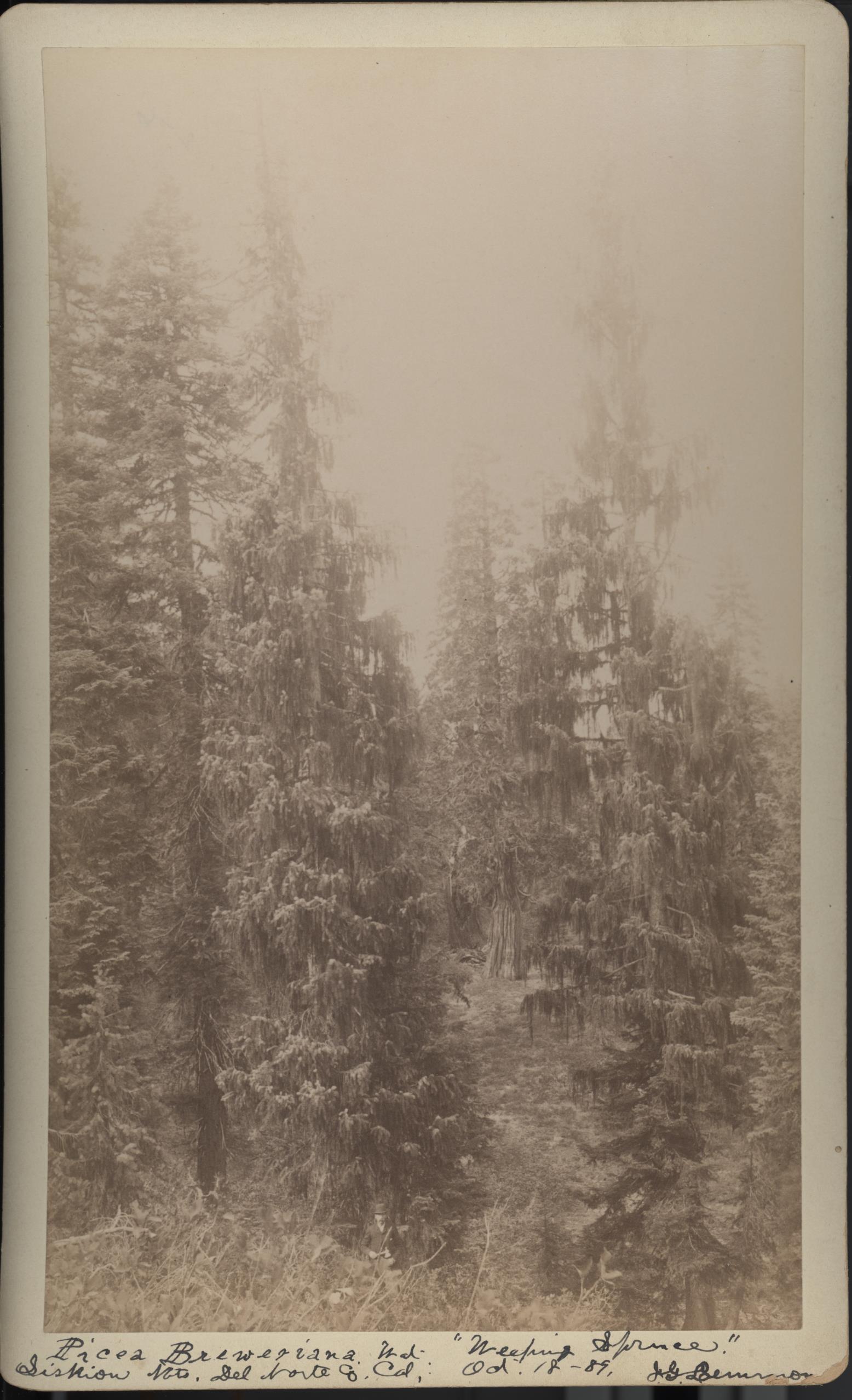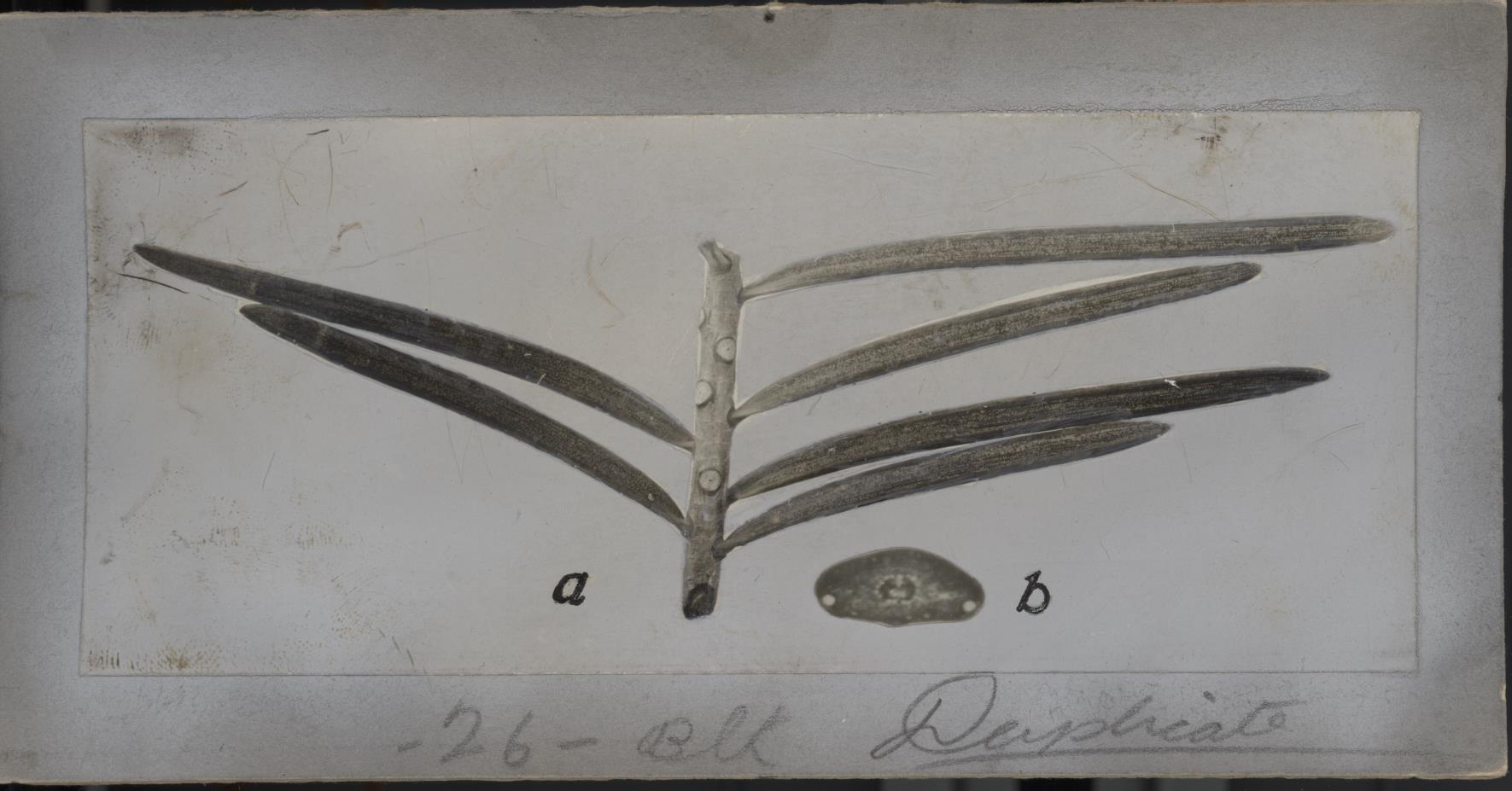
A sepia photograph on a 5.25"x8.5" piece of cardstock depicting Weeping Spruce trees in a forested area. Photographed by J.G. Lemmon.

A sepia photograph on a 5.25"x8.5" piece of cardstock depicting Weeping Spruce trees in a forested area. Photographed by J.G. Lemmon.
This blog post contributed by Sarah Take, Graduate Desk Assistant.
The Special Collections Research Center is pleased to announce that the collection guide for the newly processed Fir and Spruce Tree Photographs by John Gill Lemmon and Burton Orange Longyear (MSS 00453) is available online. This small collection includes five black and white photo cards, all depicting either fir or spruce trees. The smallest photo card is not dated and was taken by botanist Burton Orange Longyear (1868–1969). Three of the four larger photos were taken by botanist John Gill (J.G.) Lemmon (1832-1908) in 1889 in Siskiyou National Forest. The fourth is assumed to be taken by Lemmon in 1889 as well, though his signature and the date are not included on it.
While the photos themselves are fascinating, the people that captured them are equally as interesting, notably J.G. Lemmon. Lemmon was an American botanist, Civil War veteran, and former prisoner of war. He acquired an interest in botany while living with his family postwar; collecting and identifying plants unknown to settlers was something that gave him solace while he recovered from the horrors of war. In 1880, Lemmon married fellow botanist Sara Plummer (1836-1923) who was also an artist, librarian, natural historian, and former Civil War nurse. In 1881, during their honeymoon, she became the first European-descended woman to climb Mount Lemmon, which was named after her. Plummer also led the movement to have the California Poppy established as the state flower of California, while Lemmon served as the state botanist for the California State Board of Forestry.
Together, Sara and J.G. went on to identify a wide variety of plants in the Western United States and to establish an herbarium in Oakland, CA. It is unknown whether Sara was with J.G. for the photographs taken in Siskiyou National Forest, but it is entirely possible that she was since the two would go on botanical expeditions together. These photos were also taken during the time period that Lemmon served on the California State Board of Forestry, so they may be related to his work with them.
The photographer of the fifth image in our collection, captioned “fig 31 Abies Concolor”, is Burton Orange Longyear, an American botanist, forester, mycologist, and gem cutter. Originally a registered pharmacist, Longyear studied botany and chemistry at the State Agricultural College of Michigan (now Michigan State University). He ended up teaching and working as a botanist at the college before graduating with a Bachelor of Science in 1903. In 1904, he moved on to become an instructor in botany and horticulture at Colorado Agricultural College (CAC), now Colorado State University. In 1909 he became head of the newly established department of botany and forestry at CAC, before serving as State Forester of Colorado from 1912-1915. He returned to teaching after that and continued to do so until his retirement in 1936.

It is unknown whether or not Longyear had a connection to Lemmon and Plummer. Despite him and Lemmon both being botanists and foresters, the former’s work was primarily based in Michigan and Colorado, while the latter’s was primarily based in California and Arizona. We have yet to find any evidence that the two interacted on any level.
Finally, an interesting thing to note about this collection is the format of the photographs. All five of them are mounted on cardstock, which was common towards the end of the 19th century. Photos like the four larger ones in this collection were called “boudoir cards”, which specifically refer to the card-mounted photography along with the size they come in, which is 8.5 by 5.25 inches. More common in this era were “cabinet cards”, which were similarly mounted but 4.5 by 6.5 inches instead. The smallest of the photos in our collection, “fig 31 Abies Concolor”, does not correspond to any particular style of mounted photograph because of its unusual dimensions of 3 by 6 inches.
For those interested in finding out more about the John and Sara Lemmon, the University of California at Berkeley has the John and Sara (Plummer) Lemmon papers in their University and Jepson Herbaria Archives. The Lemmon Herbarium was also donated to the University of California at Berkeley. Michigan State University has the Burton Orange Longyear papers, which is a small collection consisting of a letter and photograph from C.H. Kaufman. For more information about card photographs, Oregon State University has several collections on early photographic formats, including cabinet and boudoir cards.
NC State University also has many collections related to botany and forestry in our holdings, including the Carl Alwin Schenck Papers and the College of Natural Resources, School Forests Records. If you have any questions or are interested in viewing Special Collections materials, please contact us at library_specialcollections@ncsu.edu or submit a request online. The Special Collections Research Center is open by appointment only. Appointments are available Monday–Friday, 9am–6pm and Saturday, 1pm–5pm. Requests for a Saturday appointment must be received no later than Tuesday of the same week.